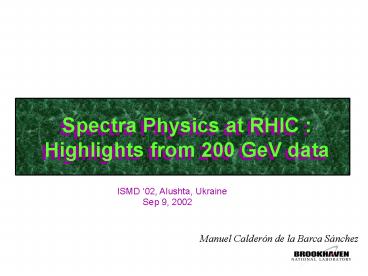Spectra Physics at RHIC - PowerPoint PPT Presentation
Title:
Spectra Physics at RHIC
Description:
Blastwave Fits at 130 & 200 GeV. Fits M. ... blastwave fit (green line) pT prediction for. Tch = 170 MeV. and b =0 ... with a blastwave fit at RHIC ... – PowerPoint PPT presentation
Number of Views:79
Avg rating:3.0/5.0
Title: Spectra Physics at RHIC
1
ISMD 02, Alushta, Ukraine Sep 9, 2002
Manuel Calderón de la Barca Sánchez
2
Understanding Bulk Matter in HI collisions
- Studying Matter
- Global Observables Nch, ?ET?, ?pT?
- ? e, S,
- Particle Yields Ratios
- ? Tch, mB, mS,
- Particle Spectra
- ? Tfo, flow, stopping,
STAR preliminary
3
Nch Centrality Dependence at RHIC (SPS)
PHOBOS AuAu hlt1
200 GeV
130 GeV
AuAu
19.6 GeV preliminary
(preliminary)
- Everything counts
- Nchh0 described nicely by Kharzeev-Nardi (hard
soft) - ?Nch? scales with Npart
4
?ET?/ ?Nch ? from SPS to RHIC
PHENIX preliminary
PHENIX preliminary
Independent of centrality
Independent of energy
Surprising fact SPS ? RHIC increased flow, all
particles higher ?pT? still ?ET?/ ?Nch? changes
very little Does different composition
(chemistry) account for that?
5
?pT? of Charged Hadrons from SPS to RHIC
increase only 2
STAR preliminary
Saturation model J. Schaffner-Bielich, et al.
nucl-th/0108048 D. Kharzeev, et al. hep-ph/0111315
Many models predict similar scaling (incl. hydro)
Need data around ?s 70 GeV to verify (or
falsify)
6
Ratios
- Huge amount of results from all 4 RHIC
experiments - systematic studies of p-/p, K-/K, ?p/p,??/?
,??/?,??/?, p/p, K/p , ?/?, ?/h, ???, ?/p, f/K,
K/K, - many as function of pT, Npart
- at ?s of (20), 130, and 200 GeV
- Problem with and without feed-down correction
- BRAHMS ? large y coverage and reach to high pT
- PHENIX ? reach to high pT
- STAR ? multi-strange baryons
7
Ratios at RHIC I vs. p
All experiments p-/p ? 1 K-/K ? 0.95
Does ?p/p also stay constant, or does it begin
falling?
8
Ratios at RHIC II vs. y
BRAHMS 200 GeV
At mid-rapidity Net-protons dN/dy ? 7 proton
yield dN/dy ? 29 ? ¾ of all protons from
pair-production
9
K-/K and ?p/p from AGS to RHIC
Slightly different view of statistical
model. Becattini calculation using statistical
model T170, gs1 (weak dependency) vary mB/T ?
K/K- and?p/p K- /K(?p/p)1/4 is a empirical
fit to the data points K-/K driven by ms
exp(2ms/T) ?p/p driven by mB
exp(-2mB/T) ms ms (mB) since ltSgt 0
BUT Holds for y ? 0 (BRAHMS y3)
10
Rapidity Spectra Boost-Invariance at RHIC ?
D. Ouerdane (BRAHMS)
11
Boost-Invariance at RHIC ?
p-
p-
- dN/dy of pions looks boost-invariant BUT
- change in slopes for rapidity already from 0 ? 1
- BRAHMS (J.H. Lee) no change in proton slope
from y 0 ? 3 BUT increase
in dN/dy - ? Boost invariance only achieved in small region
ylt0.5
12
Identified Particle Spectra at RHIC _at_ 200 GeV
BRAHMS 10 central PHOBOS 15 PHENIX 5 STAR
5
Feed-down matters !!!
13
Interpreting the Spectra
- The shape of the various particle spectra teach
us about - Kinetic freeze-out temperatures
- Transverse flow
- The stronger the flow the less appropriate are
simple exponential fits - Hydrodynamic models (a la Heinz/Kolb/Shuryak/Huovi
nen/Teaney) - Hydro inspired parameterizations (Blastwave)
- Blastwave parameterization
- Ref. E.Schnedermann et al, PRC48 (1993) 2462
- (modifications by Snellings,
Voloshin) - Very successful in recent months
- Spectra
- HBT (incl. the Rout/Rside puzzle)
- Flow
spectra (p)
HBT
?b?
14
Blastwave Fits at 130 200 GeV
Results depend slightly on pT coverage STAR Tfo
100 MeV ?bT? 0.55c (130) 0.6c
(200) PHENIX Tfo 110 MeV (200) ?bT? 0.5c
(200)
200 GeV
Fits M. Kaneta (STAR)
15
What flows and when?
ltpTgt prediction with Tth and ltbgt obtained from
blastwave fit (green line)
STAR
ltpTgt prediction for Tch 170 MeV and ltbgt0 pp
no rescattering, no flow no thermal equilibrium
preliminary F. Wang
? and ? appear to deviate from common thermal
freeze-out Smaller ?elast? Early decoupling from
expanding hadronic medium? Less flow? What about
partonic flow?
16
Does it flow? Fits to Omega mT spectra
STAR preliminary
RHIC
SPS/NA49
bT is not well constrained !
- What do we now about ?elast of ? and ? ?
- May be it flows, and may be they freeze out with
the others - Maybe ? and ? are consistent with a blastwave
fit at RHIC - Need to constrain further ? more data much
more for v2 of ?
17
Other Attempts The Single Freeze-Out Model
- Single freeze-out model (TchTfo)
- (W. Broniowski et. al) fit the data well (and
reproduce f, K, L, X, W) - ? Thermal fits to spectra are not enough to make
the point. - To discriminate between different models they
have to prove their validity by describing - Spectra (shape yield)
- Correlations (HBT, balance function, etc.)
- Flow
- Only then we can learn
18
Conclusions
- Flood of data from SPS RHIC
- new probes
- correlations between probes
- higher statistics precision
- Models (Generators) are behind
- The majority of models in RHI fail already
describing global observables (possible exception
AMPT) - Many models describe A well but fail badly at
B - ? can still be useful but limited scope
- We learn more by combing various pieces and
putting them into context - Thermalization, Chemical and Kinetic Freeze-out
Conditions, and System Dynamics can only be
studied (and are studied) using all the pieces
together - Agreement between thermal fits to particle
spectra and ratios flow makes a very strong
case for thermalization of matter created at RHIC































